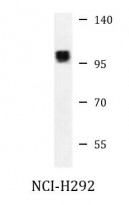ARG58596
anti-NFATc1 antibody
anti-NFATc1 antibody for IHC-Formalin-fixed paraffin-embedded sections,Western blot and Human
Overview
| Product Description | Rabbit Polyclonal antibody recognizes NFATc1 |
|---|---|
| Tested Reactivity | Hu |
| Tested Application | IHC-P, WB |
| Host | Rabbit |
| Clonality | Polyclonal |
| Isotype | IgG |
| Target Name | NFATc1 |
| Antigen Species | Human |
| Immunogen | KLH-conjugated synthetic peptide between aa. 898-927 of Human NFATc1. |
| Conjugation | Un-conjugated |
| Alternate Names | NFATc1; NFAT transcription complex cytosolic component; NFAT2; NF-ATC; NF-ATc; NF-ATc1; Nuclear factor of activated T-cells, cytoplasmic 1; NFATc; NF-ATc1.2 |
Application Instructions
| Application Suggestion |
|
||||||
|---|---|---|---|---|---|---|---|
| Application Note | * The dilutions indicate recommended starting dilutions and the optimal dilutions or concentrations should be determined by the scientist. | ||||||
| Positive Control | NCI-H292 |
Properties
| Form | Liquid |
|---|---|
| Purification | Purification with Protein A and immunogen peptide. |
| Buffer | PBS and 0.09% (W/V) Sodium azide. |
| Preservative | 0.09% (W/V) Sodium azide |
| Storage Instruction | For continuous use, store undiluted antibody at 2-8°C for up to a week. For long-term storage, aliquot and store at -20°C or below. Storage in frost free freezers is not recommended. Avoid repeated freeze/thaw cycles. Suggest spin the vial prior to opening. The antibody solution should be gently mixed before use. |
| Note | For laboratory research only, not for drug, diagnostic or other use. |
Bioinformation
| Database Links |
Swiss-port # O95644 Human Nuclear factor of activated T-cells, cytoplasmic 1 |
|---|---|
| Gene Symbol | NFATC1 |
| Gene Full Name | nuclear factor of activated T-cells, cytoplasmic, calcineurin-dependent 1 |
| Background | The product of this gene is a component of the nuclear factor of activated T cells DNA-binding transcription complex. This complex consists of at least two components: a preexisting cytosolic component that translocates to the nucleus upon T cell receptor (TCR) stimulation, and an inducible nuclear component. Proteins belonging to this family of transcription factors play a central role in inducible gene transcription during immune response. The product of this gene is an inducible nuclear component. It functions as a major molecular target for the immunosuppressive drugs such as cyclosporin A. Multiple alternatively spliced transcript variants encoding distinct isoforms have been identified for this gene. Different isoforms of this protein may regulate inducible expression of different cytokine genes. [provided by RefSeq, Jul 2013] |
| Function | Plays a role in the inducible expression of cytokine genes in T-cells, especially in the induction of the IL-2 or IL-4 gene transcription. Also controls gene expression in embryonic cardiac cells. Could regulate not only the activation and proliferation but also the differentiation and programmed death of T-lymphocytes as well as lymphoid and non-lymphoid cells. [UniProt] |
| Cellular Localization | Cytoplasm. Nucleus. Note=Cytoplasmic for the phosphorylated form and nuclear after activation that is controlled by calcineurin-mediated dephosphorylation. Rapid nuclear exit of NFATC is thought to be one mechanism by which cells distinguish between sustained and transient calcium signals The subcellular localization of NFATC plays a key role in the regulation of gene transcription. [UniProt] |
| Calculated MW | 101 kDa |
| PTM | Phosphorylated by NFATC-kinase and GSK3B; phosphorylation induces NFATC1 nuclear exit and dephosphorylation by calcineurin promotes nuclear import. Phosphorylation by PKA and DYRK2 negatively modulates nuclear accumulation, and promotes subsequent phosphorylation by GSK3B or casein kinase 1. [UniProt] |
Images (2) Click the Picture to Zoom In







